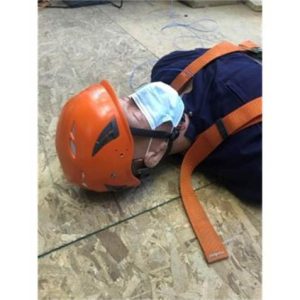Construction Helmets and Work-related Traumatic Brain Injury
Posted on byTraumatic brain injury (TBI) is a disruption in the normal function of the brain that can be caused by a bump, blow, or jolt to the head, or penetrating head injury. TBIs are a global public health problem and is a leading cause of injury-related death and disability [1]. While TBIs can be mild, some can be fatal or cause short- to long-term disability. Those occurring among participants in collision sports such as football are often called concussions and have been receiving increasing attention in medical literature [2] and the media.
A common occupational injury, TBI occurring at work is referred to as work-related traumatic brain injury (WR TBI) and accounts for between 20% and 25% of work-related trauma [3]. More severe TBIs can impact a worker’s ability to return to their preinjury job and be expensive for both workers and employers in long-term rehabilitation and disability costs. Continue reading to learn about NIOSH efforts to prevent WR TBI in the construction industry.
Work-related Traumatic Brain Injury in Construction
The construction industry has the greatest number of both fatal [4] and nonfatal [5] WR TBI among U.S. workplaces. From 2003 to 2010, 2,210 construction workers died because of a TBI (a rate of 2.6 per 100,000 full time equivalent workers). These deaths represented 25% of all construction fatalities and 24% of all WR TBI fatalities among all industries during that period [3].
Construction Workers at Risk
Construction workers are at higher risk for TBIs because of their work in dynamic environments where they can be struck by falling and flying objects or fall from elevation [6, 7]. Falls, especially from roofs, ladders, and scaffolds, led to more than half of fatal WR TBIs [3].
Research [5] shows that:
- Workers in small construction companies (<20 employees) were over 2.5 times more likely than those in larger companies (≥100 employees) to die from a TBI;
- Older workers (≥65 years) were almost 4 times more likely than younger workers (25–34 years) to have a fatal TBI;
- The TBI fatality rate was significantly higher for foreign-born than for native-born workers; and
- Structural iron and steel workers and roofers had the highest fatal TBI rate among construction workers.
Prevention of Work-related Traumatic Brain Injury
NIOSH and its partners are working to prevent WR TBIs. Consistent with the hierarchy of controls, prevention of WR TBIs should begin with efforts to ‘design out’ hazards and to use engineering and administrative controls at construction worksites and among construction workers. These prevention efforts are important parts of existing prevention programs — such as programs on prevention of falls, being struck by or against an object or equipment, and motor vehicle crashes.

PPE for Prevention – Construction Helmets
Use of personal protective equipment (PPE) such as helmets remains essential in many construction settings to prevent injury. The industrial helmet (‘hard hat’), originally developed over a hundred years ago, is a common piece of personal protective equipment (PPE) intended primarily to protect workers from head injuries due to falling objects or overhead hazards.* In fact, NIOSH gives an annual award in honor of Edward W. Bullard, the designer of the first hard hat.
In the U.S., the Occupational Safety and Health Administration (OSHA) regulates the use of hard hats in the construction industry as part of the head protection standard [29 CFR § 1926.100 Head protection – Code of Federal Regulations]. The OSHA standard refers directly to consensus standards from the American National Standards Institute (ANSI) Z89.1 American National Standard for Industrial Head Protection.
Helmets used in the construction industry have ‘Type I’ and ‘Type II’ designations. Type I helmets are designed to reduce the force resulting from a blow to the top of the head, while Type II helmets are designed to reduce the force resulting from a blow to either the top or sides of the head. Lateral (from the side) impacts, such as impacts from some falls and from some sports activities, are likely to cause rotational accelerations in the brain, which is a mechanism of injury leading to concussions among workers experiencing head trauma [8, 9]. †
The Type I helmet is a basic model that has traditionally been used on construction sites [10]. Helmets have several design features to help keep a helmet on the wearer’s head (the ‘retention system’). The retention system of a construction helmet typically consists of a removable chin strap and a suspension system. The suspension system includes a head cradle, which is attached to the helmet shell via four to six anchors, and a suspension tightening ‘ratchet.’ Chin straps are important for applications where the helmet can become dislodged from the user’s head. Based on OSHA/ANSI standards, Type I and Type II construction helmets do not require the use of chin straps. There are no design requirements related to chinstraps for Type I helmets. However, when Type II helmets are supplied with a chinstrap, they must meet width, retention and elongation requirements as defined in the ANSI standard. ††
Work is underway in studying the performance and design of newer construction helmets at NIOSH (see below). Important considerations involve availability, accessibility, acceptability, and knowledge of PPE for all user groups, including workers of all sizes, sexes, races, ethnicities, or linguistic groups. Another consideration is cost – a recent discussion estimated that helmets with newer designs cost around five times as much as traditional helmets [10].
Research – Helmet Design
Studying the performance and design of helmets is one way that NIOSH researchers are working to decrease WR TBI. Current projects are evaluating helmets to improve personal protection from struck-by events and falls [11, 12]. Recent studies have evaluated the shock absorption characteristics of the suspension system and cushioning for construction helmets and the fall protection performance of construction helmets.
- Air-bubble cushions have been widely used in commercial packaging for shock absorption; however, air-bubble cushions have never been used in construction helmets. In 2021, NIOSH research found that adding an air-bubble cushioning liner to a Type I construction helmet will substantially increase shock absorption from large and repeated impacts [12, 13]. Based on initial performance of air bubble cushioning to improve construction helmet shock absorption, a nonprovisional patent application was filed [14]. Newer helmet designs which had an additional foam layer between the belt-type suspension and the shell offered significantly more protection than basic Type I helmet designs, thereby, reducing the probability of serious head injury nearly 30% [11, 14].
-

Experimental manikin with helmet. Photo from NIOSH. NIOSH assessed fall protection performance in a study using manikins wearing different types of construction helmets hoisted to a height of five feet and dropped to two different surfaces. The study found that all evaluated helmets had excellent performance for fall protection and that the fall protection performance of the newer helmets was substantially better than the basic Type I helmets [11].
- NIOSH is starting a new research project to evaluate improvements in helmet shock absorption performance with new, custom, air-bubble cushion liners. This is a collaboration with helmet manufacturers and ANSI representatives from the Z89.1 Standard for Industrial Head Protection Committee.
Looking for Input on This Topic
If construction helmets are or should be used at your workplace, we are interested in your input.
- Is your workplace using Type I or Type II helmets?
- What do you see as the advantages and drawbacks or limitations to Type I or II helmets?
- Do your helmets have chin straps? Are the chin straps being worn? If so, during which applications?
- Have you used any of the ‘newer’ helmets? If so, have you experienced advantages, drawbacks, or limitations?
- For companies using ‘newer’ helmets, what factors were considered in deciding to purchase them?
Douglas Trout, MD, MHS, is Deputy Director for the NIOSH Office of Construction Safety and Health.
G. Scott Earnest, PhD, PE, CSP, is the Associate Director for the NIOSH Office of Construction Safety and Health.
Christopher Pan, PhD, CPE, is a Research Safety Engineer in the Protective Technology Branch in the NIOSH Division of Safety Research.
John Z. Wu, PhD, is a Research Mechanical Engineer in the Physical Effects Research Branch in the NIOSH Health Effects Lab Division.
This blog has been translated into Spanish.
Websites – Resources
CPWR Internet Page CPWR | Preventing Head Injuries
Traumatic Brain Injury / Concussion | Concussion | Traumatic Brain Injury | CDC Injury Center
OSHA [2019]. 29 CFR 1926.100 Head Protection. Washington DC: U.S. Department of Labor, Occupational Safety and Health Administration. eCFR :: 29 CFR 1926.100 — Head protection.
References
- Maas AIR, et al [2022]. Traumatic brain injury: progress and challenges in prevention, clinical care, and research, The Lancet Neurology. https://www.thelancet.com/article/S1474-4422(22)00309-X/fulltext
- Canseco, JA, et al [2022]. Overview of Traumatic Brain Injury in American Football Athletes. Clinical Journal of Sport Medicine: May 2022 – Volume 32(3):236-247. https://doi.org/10.1097/JSM.0000000000000918
- Konda S, Tiesman HM, Reichard AA [2016]. Fatal traumatic brain injuries in the construction industry, 2003–2010. Am J Ind Med 59(3):212–220. https://onlinelibrary.wiley.com/doi/full/10.1002/ajim.22557
- Tiesman H, Konda S, Bell J [2011]. The Epidemiology of Fatal Occupational Traumatic Brain Injury in the United States, Am J Prev Med, 41(1):61-7. https://www.sciencedirect.com/science/article/pii/S0749379711002005
- Konda S, Reichard A, Tiesman HM, Hendricks S [2015]. Nonfatal occupational traumatic brain injuries treated in U.S. hospital emergency departments: 1998-2007. Inj Prev, 21:115–120. https://injuryprevention.bmj.com/content/injuryprev/21/2/115.full.pdf
- Konda S, et al [2020]. Workers’ compensation claims for traumatic brain injuries among private employers—Ohio, 2001‐2011. AJIM: 63:156–169. https://onlinelibrary.wiley.com/doi/10.1002/ajim.23073
- Liu M, et al [2011]. Work-related mild-moderate traumatic brain injury and the construction industry. Work 39:283–290. https://pubmed.ncbi.nlm.nih.gov/21709364/
- Rowson S and Duma SM [2013]. Brain Injury prediction: assessing the combined probability of concussion using linear and rotational head acceleration. Annals of Biomedical Engineering 41(5): 873-882. DOI: 10.1007/s10439-012-0731-0
- Harlos AR and Rowson S [2021]. Laboratory reconstruction of real-world bicycle helmet impacts. Annals of Biomedical Engineering 49 (10):2827-2835. https://doi.org/10.1007/s10439-021-02860-6
- Langbehn, MR [2021]. Workers head protection preferences in construction. Available at: https://digitalcommons.calpoly.edu/cmsp/501/
- Wu JZ, Pan CS, Cobb C, Moorehead A, Kau TY, and Wimer BM [2022]. Evaluation of the Fall Protection of Type I Industrial Helmets. Annals of Biomedical Engineering. https://doi.org/10.1007/s10439-022-02922-3
- Wu JZ, Pan CS, Ronaghi M, Wimer BM, Reischl U [2021]. Application of polyethylene air-bubble cushions to improve the shock absorption performance of type I construction helmets for repeated impacts. Biomed Mater Eng. 32(1): 1–14. https://doi.org/10.3233/BME-201132.
- Wu, JZ, Pan, CS, Ronaghi, M, Wimer, B, and Reischl, U [2020]. Application of air-bubble cushioning to improve the shock absorption performance of type I industrial helmets. Engineering Failure Analysis. https://doi.org/10.1016/j.engfailanal.2020.104921.
- Pan, CS, Wu, JZ, and Reischl, U [2021]. “Headgear systems with Air-Bubble Cushioning Liner for Improved Shock Absorption Performance” U.S. Patent Application No. 17/160,177. Washington, DC: U.S.
* While not the primary subject of this blog, protective helmets are also organized by classes with regard to protection from electrical shock hazard
†† ANSI-ISEA Z89.1:2014 Section 7.2.3 Chin Strap
† Text edited to include additional research. Note that the reference numbers have changed.
Posted on by

